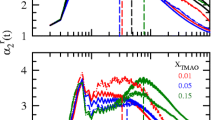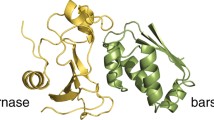Abstract
Dielectric dispersion and NMRD experiments have revealed that a significant fraction of water molecules in the hydration shell of various proteins do not exhibit any slowing down of dynamics. This is usually attributed to the presence of the hydrophobic residues (HBR) on the surface, although HBRs alone cannot account for the large amplitude of the fast component. Solvation dynamics experiments and also computer simulation studies, on the other hand, repeatedly observed the presence of a non-negligible slow component. Here we show, by considering three well-known proteins (lysozyme, myoglobin and adelynate kinase), that the fast component arises partly from the response of those water molecules that are hydrogen bonded with the backbone oxygen (BBO) atoms. These are structurally and energetically less stable than those with the side chain oxygen (SCO) atoms. In addition, the electrostatic interaction energy distribution (EIED) of individual water molecules (hydrogen bonded to SCO) with side chain oxygen atoms shows a surprising two peak character with the lower energy peak almost coincident with the energy distribution of water hydrogen bonded to backbone oxygen atoms (BBO). This two peak contribution appears to be quite general as we find it for lysozyme, myoglobin and adenylate kinase (ADK). The sharp peak of EIED at small energy (at less than 2 k B T) for the BBO atoms, together with the first peak of EIED of SCO and the HBRs on the protein surface, explain why a large fraction (~ 80%) of water in the protein hydration layer remains almost as mobile as bulk water. Significant slowness arises only from the hydrogen bonds that populate the second peak of EIED at larger energy (at about 4 kBT). Thus, if we consider hydrogen bond interaction alone, only 15–20% of water molecules in the protein hydration layer can exhibit slow dynamics, resulting in an average relaxation time of about 5–10 ps. The latter estimate assumes a time constant of 20–100 ps for the slow component. Interestingly, relaxation of water molecules hydrogen bonded to back bone oxygen exhibit an initial component faster than the bulk, suggesting that hydrogen bonding of these water molecules remains frustrated. This explanation of the heterogeneous and non-exponential dynamics of water in the hydration layer is quantitatively consistent with all the available experimental results, and provides unification among diverse features.

This study reveals a bimodal electrostatic energy distribution of protein–water hydrogen bonds involving side chain oxygen and faster than bulk water hydrogen bond breaking dynamics of protein–water hydrogen bond involving backbone oxygen.
Similar content being viewed by others
References
(a) Bagchi B 2005 Chem. Rev. 105 3197; (b) Nandi N, Bhattacharyya K and Bagchi B 2000 Chem. Rev. 100 2013
Levy Y and Onuchic J N 2006 Annu. Rev. Biophys. Biomol. Struct. 35 389
Raschke T M 2006 Curr. Opin. Struct. Biol. 16 152
Ohmine I and Tanaka H 1993 Chem. Rev. 93 2545
(a) Bhattacharyya K 2008 Chem. Commun. 2848; (b) Bhattacharyya K 2003 Acc. Chem. Res. 36 95; (c) Sahu K, Mondal S K, Ghosh S and Bhattacharyya K 2007 Bull. Chem. Soc. Jpn 80 1033
Daniel R M, Finney J L and Stoneham M 2004 Philos. Trans. R. Soc. London, Ser. B 359 1143
Timasheff S N 1993 Annu. Rev. Biophys. Biomol. Struct. 22 67
Nandi N and Bagchi B 1997 J. Phys. Chem. B 101 10954
Nandi N and Bagchi B 1998 J. Phys. Chem. A 102 8217
Chakraborty S and Bandopadhyay S 2007 J. Phys. Chem. B 111 7626
Chakraborty S, Bandopadhyay S and Bagchi B 2005 J. Am. Chem. Soc. 127 16660
Pal S, Maiti P K and Bagchi B 2006 J. Chem. Phys. 125 234903
Jordanides X J, Lang M J, Song X and Fleming G R 1999 J. Phys. Chem. B 103 7995
Murarka R K and Head-Gordon T 2008 J. Phys. Chem. B 112 179
Murarka R K and Head-Gordon T 2007 J. Chem. Phys. 126 215101
Pizzitutti F, Marchi M, Sterpone F and Rossky P J 2007 J. Phys. Chem. B 111 7584
Hassanali A A, Li T, Zhong D and Singer S J 2006 J. Phys. Chem. B 110 10497
Li T, Hassanali A A, Kao Y-T, Zhong D and Singer S J 2007 J. Am. Chem. Soc. 129 3376
Khoshtariya D E, Hansen E, Leecharoen R and Walker G C 2003 J. Mol. Liq. 105 13
Yokomizo T, Higo J and Nakasako M 2005 Chem. Phys. Lett. 410 31
Thibodeaul P H, Brautigam C A, Machius M and Thomas P J 2004 Nat. Struct. Mol. Biol. 12 10
Honig B and Cohen F E 1996 Folding Design 1 R17
Sen P, Mukherjee S, Halder A and Bhattacharyya K 2004 Chem. Phys. Lett. 385 357
Pal S K, Peon J, Bagchi B and Zewail A H 2002 J. Phys. Chem. B 106 12376
(a) Halle B 2004 Phil. Trans. R. Soc. Lond. B 359 1207; (b) Halle B and Davidovic M 2003 Proc. Natl. Acad. Sci. USA 100 12135
Jana B, Pal S and Bagchi B 2008 J. Phys. Chem. B 112 9112
van der Spoel B, Lindahl E, Hess B, van Buuren A R, Apol E, Meulenhoff P J, Tieleman D P, Sijbers A L T M, Feenstra K A, van Drunen R and Berendsen H J C 2004 Gromacs User Manual version 3.2, www.gromacs.org
Berendsen H J C, Grigera J R and Straatsma T P 1987 J. Chem. Phys. 91 6269
(a) Darden T, York D and Pedersen L 1993 J. Chem. Phys. 98 10089; (b) Essmann U, Perera L, Berkowitz M L, Darden T, Lee H and Pedersen L G 1995 J. Chem. Phys. 103 8577
Rey R, Møller K B and Hynes J T 2002 J. Phys. Chem. A 106 11993
Schneider B, Cohen D and Berman H M 1992 Biopolymers 32 725
Reddy C K, Das A and Jayram B 2001 J. Mol. Biol. 314 619
Cheng Y-K and Rossky P J 1998 Nature 392 696
Cheng Y-K and Rossky P J 1999 Biopolymers 5 742
Laage D and Hynes J T 2006 Science 311 832
Chandra A 2000 Phys. Rev. Lett. 85 768
Stillinger F H 1975 Adv. Chem. Phys. 31 1
Author information
Authors and Affiliations
Corresponding author
Additional information
#Dedicated to Prof. N Sathyamurthy on his 60th birthday
Rights and permissions
About this article
Cite this article
JANA, B., PAL, S. & BAGCHI, B. Hydration dynamics of protein molecules in aqueous solution: Unity among diversity# . J Chem Sci 124, 317–325 (2012). https://doi.org/10.1007/s12039-012-0231-7
Published:
Issue Date:
DOI: https://doi.org/10.1007/s12039-012-0231-7




